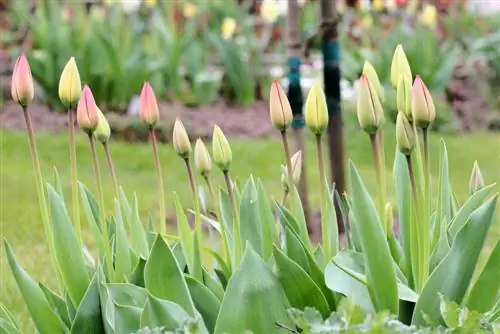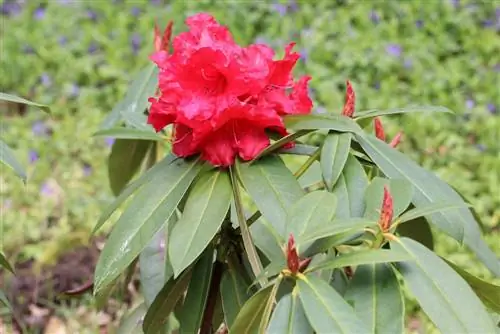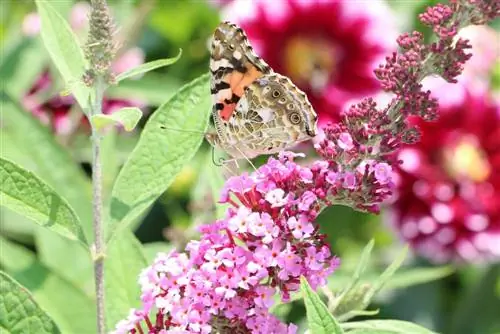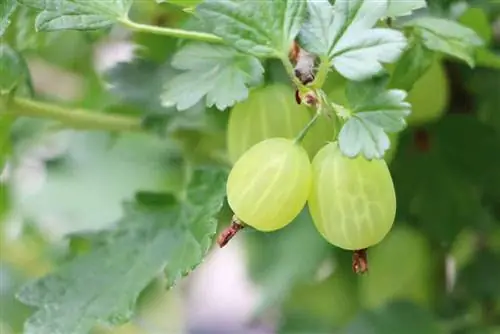- Author admin [email protected].
- Public 2023-12-17 03:39.
- Last modified 2025-06-01 06:48.
In May, a rhododendron transforms the spring garden into a breathtaking sea of flowers without having to be cut every year. Over the years, the majestic flowering bush tends to become bald from below. The forked branches with few leaves and sparse flowers detract from the magnificent appearance so much that you cannot avoid rejuvenating pruning. To ensure that the evergreen ornamental tree can easily cope with this profound cut in its growth, important aspects must be taken into account. With these instructions, gardeners will be well equipped to skillfully prune their rhododendrons at the perfect time.
The best choice of date
In order to choose the perfect time to prune rhododendrons, several criteria are important. First and foremost, the physiology of the Asian flowering shrub should be taken into account because it sets its buds the previous year. By cutting at the wrong time, you will deprive yourself of the blooms for next spring. Furthermore, the legislature has a say in the choice of date, since in Germany the habitat of birds and other wild animals is subject to special protection. The Federal Nature Conservation Act sets precise dates for when and how shrubs, hedges and other trees may be cut. The following overview summarizes the details:
- Light topiary: immediately after the end of the flowering period
- Radical rejuvenation cut: between mid-January and the end of February or in November
- According to § 39 Federal Nature Conservation Act: from March 1st to September 30th no extensive cutting or putting on the stick
For the prudent gardener, it is important to reconcile the growth-specific requirements of the rhododendron with the legal regulations when choosing a date. Moderate pruning in June after flowering is expressly permitted in the regulations, provided there are no breeding birds in the bush at that time. This requirement must also be taken into account if you decide on a time in late autumn or winter to rejuvenate your rhododendron. Disturbing and damaging wild animals is punishable all year round in Germany.
Preparatory work
Once the time for pruning has been decided, special attention is paid to the tool. Rose shears or secateurs are well suited for young, narrow shoots. To carefully shorten thicker branches, pruning shears or a hand saw are the right choice. The cutting tool should be freshly sharpened so that it can cut through the branches smoothly without damaging fraying at the edges. To ensure that no pathogens get into the rhododendron via the blade or saw blade, disinfection with alcohol is recommended.
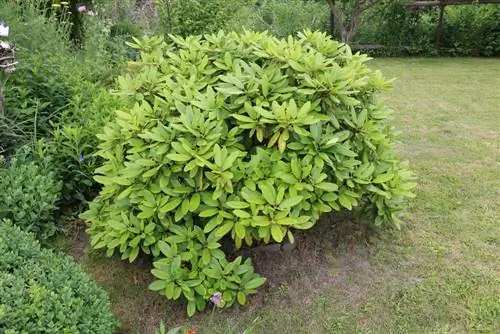
If a rejuvenation cut is planned, first examine the root ball. In compacted, clay-rich soil, sensitive rhododendron varieties fail to develop a stable root system, even after years. These specimens remain comparatively small and become bald from the base early on. The flowering bushes cannot cope with extensive pruning because they do not have the root pressure required to sprout again from the old wood.
If the root ball can be lifted out of the ground with little effort, rejuvenation pruning is a hopeless undertaking. However, a thorough cut will get a firmly rooted rhododendron with strong annual growth back on track.
Instructions for topiary
Your rhododendron naturally develops its pleasing, semicircular shape. As long as the flowering bush grows compact and with dense leaves, you can leave it alone without pruning. If a bunch of branches stick out of the shape, cut them back after the flowering period. To save your flower primus the effort of producing seeds, you can clean out withered flowers at the end of June/beginning of July. To do this, place the scissors just above the next pair of he althy leaves so that you cut off everything that has bloomed, including the stem.
Don't have any scissors handy right now? Then you can easily break out the dead flowers by hand. Grasp the stem with your fingers and break it to the side. This technique should also be used to remove any black buds. There is a pest in there that is effectively combated in this way.
Tip:
After flowering is a good time to treat a rhododendron with fertilizer. A portion of leaf compost with horn shavings or a mineral-organic special fertilizer for rhododendrons effectively prevent deficiency symptoms.
Instructions for the rejuvenation cut
If you have prescribed radical pruning for your aging rhododendron, there should be no frosty weather on the chosen date. How to do it professionally:
- Put on long-sleeved clothing and gloves to protect against the toxic ingredients
- Carefully examine the entire bush for birds or other small animals
- If there are no animal inhabitants, cut off all bare shoots to a height of 30 to 50 cm
- Feel a sleeping eye under the bark on the branch with your fingers
- Place the scissors or saw about 1 thumb's width above the bud
- Make the cut at a slight angle so that water can drain away quickly
Don't be afraid to saw off branches as thick as your arm down to knee height. As long as there is at least one sleeping eye on the shoot, your rhododendron will happily sprout again. However, this does not apply to dead wood. If you notice completely dead branches, they are cut off close to the ground or on the branch so as not to hinder or shade vital branches as they sprout. A cut on Astring is made a short distance from the bulging base on the trunk or leading branch.
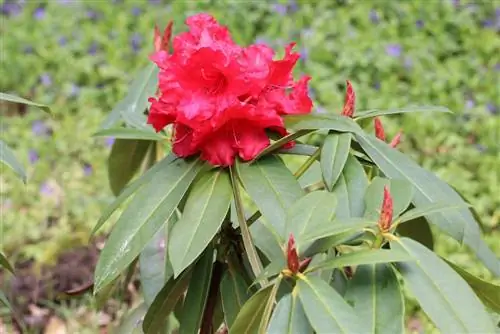
Can't you find a sleeping eye on a branch even though it doesn't look dead? Then cut the branch back by half and simply wait for the shoots to sprout. The following year, shorten the stub of old wood to 1 cm above the new shoots. With this strategy you can save valuable wood on the rhododendron and use it to build a new crown.
Tip:
A rhododendron has to regenerate in the first two years after a rejuvenation cut. Therefore, do not replant the flowering bush during this time, otherwise it will no longer sprout.
Cut noble hybrids in stages
Hybrids grafted on a wild rootstock require more moderate pruning than robust rhododendrons propagated from cuttings. A radical cut could encourage the substrate to sprout. To prevent this unfavorable process from starting, we recommend a rejuvenation cut in two stages. This strategy is also advisable for those plant lovers who cannot bring themselves to radically prune. Follow these steps to do it right:
- In the first winter, cut half of the branches to 30 to 50 cm
- The following year, shorten the remaining shoots to knee height
Thanks to this procedure, your rhododendron will not lose all of its leaf mass in one go. Therefore, the wild base has no chance of overgrowing the upper noble part and does not grow through, or only grows minimally. If you notice wild shoots pointing steeply upwards, they can be cut or torn off at any time.
Cut correctly during the flowering break
With an average annual growth of 5 to 10 cm, a rhododendron takes it easy after being pruned. As a rule, it takes 3 to 4 years until it has reached a height of around 150 cm with a dense foliage and magnificent flowers. With a light topiary in late winter you can support compact, even growth. For this purpose, cut back noticeably long, unbranched new shoots until just before a leaf node by the end of February. You only carry out this cut until the ornamental shrub produces buds again in late summer.
Wound closure - yes or no?
Pruning back into the old wood leaves wounds on impressive shrubs and trees. For many decades it was a matter of course to seal these cut surfaces with tree wax, paste or emulsion paint. Why the rhododendrons and other trees became diseased or even died despite the wound being closed remained a mystery for a long time. Intensive research revealed that the crux of the matter lies precisely in wound closure. The healing of cuts on wood is completely different than on human skin. A plaster hinders your rhododendron's self-healing powers and paves the way for pathogens and fungi.
Along the cut edges, beneath the bark, there is cell tissue capable of division, the cambium. When cut, the cambium forms wound tissue (callus) that covers the open area. If you apply wound closure to the cut surface, two harmful processes will start at once. The cambium is prevented from overflowing the wound with fresh tissue and healing. At the same time, microorganisms find ideal living conditions under the airtight layer of tree wax. This also applies if you use wound closure products with fungicides. How to properly treat cut surfaces on a rhododendron:
- Always smooth cuts with a sharp, disinfected knife
- Let your self-healing powers take their course in spring, summer and autumn
- After a winter cut, simply apply wound closure to the edges of the wound

If a radical rejuvenation cut is carried out in late winter, a rhododendron is in its dormant state. During this phase, the cambium cannot allow wound tissue to grow to cover the cut surface. Since the valuable cell tissue is exposed, it is threatened by frost and drought. With a thin layer of wound closure you protect the cambium until the beginning of the growing season.
Tips for care after the cut
A rejuvenation cut means a deep intervention in the growth of your rhododendron. In order for it to transform into an opulent flowering bush again, it needs a little more attention afterwards. With the following care program, the ornamental shrub will get off to a good start:
- Water regularly as soon as the soil has dried on the surface
- Let the water from the jug run directly onto the root disc
- Use primarily rainwater or decalcified tap water
- Shade the roots with a layer of mulch made from leaves, pine bark or bark mulch
- After pruning, fertilize with compost and horn shavings or special rhododendron fertilizer
- Do not fertilize from the end of June so that the shoots mature before winter
As a shallow-rooted rhododendron, it depends on regular watering in dry conditions. This also applies to winter frost. If the winter sun shines from a cloudless sky for days in the bitter cold without snow falling, water the ornamental shrub on mild days. A layer of mulch at least 5 cm high also effectively prevents drought stress.
Conclusion
Rhododendrons are easy-care flower beauties for the lush spring garden. The ornamental shrubs live up to this reputation without having to be cut every year. Only withered flowers can be cleaned out in June. If a rhododendron becomes bald in old age, a rejuvenation cut works wonders. The perfect time for radical pruning is January to the end of February. This choice of date also takes into account the strict regulations of the Federal Nature Conservation Act, which requires extensive cutting measures between 1. March and September 30th prohibited. These instructions get to the heart of what else you should pay attention to when cutting your ornamental shrub.



